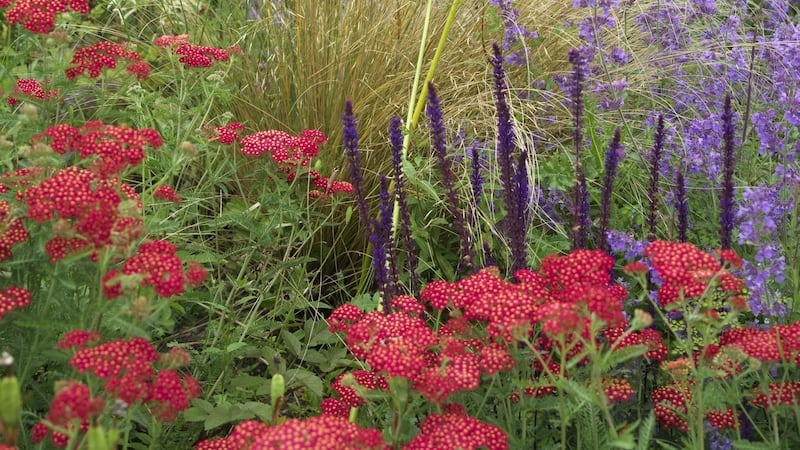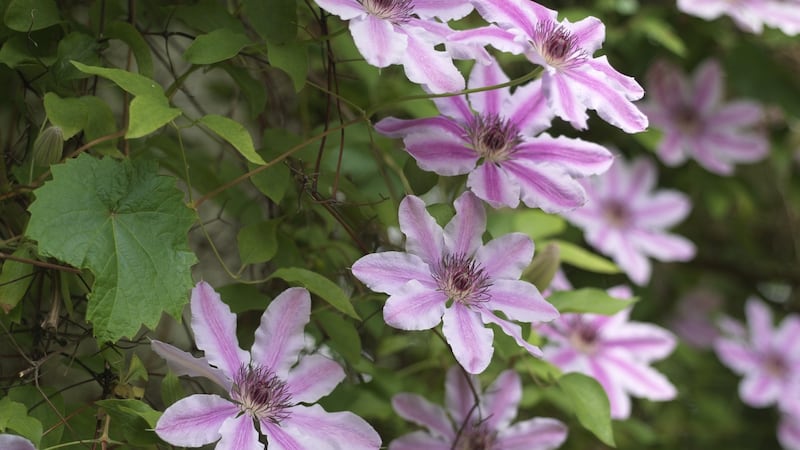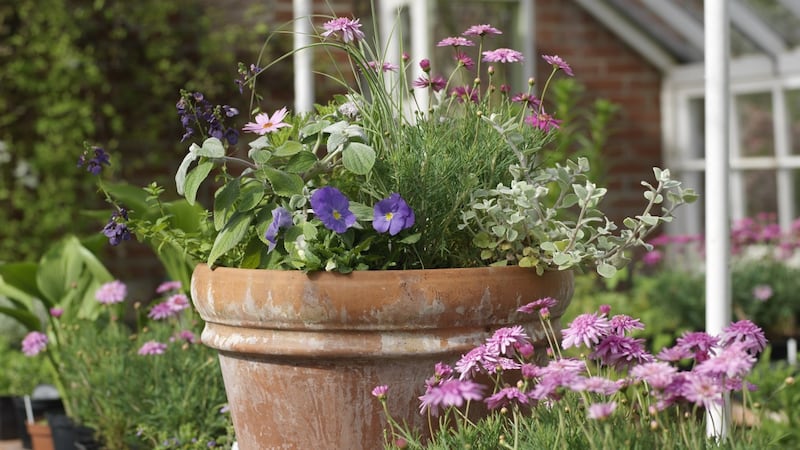Oh no – or should that be oh dear – we have deer in our garden. Or rather, we very nearly have deer, their slow but steady invasion just about kept in check by a wooden fence as well as our large, sweet-natured, noisy dog who regards their ostentatiously close presence as a deep affront to his canine pride.
How adorable, you may think, and yes, they are hugely endearing with their chocolate-brown eyes, long slender necks and graceful ways, especially the young fawns that look straight out of the Bambi casting department. But the problem, when and if you garden, is that deer are voracious eaters of almost all things leafy. This includes shrubs. Vegetables. Herbaceous perennials. Fruit bushes. Bedding plants. And of course, trees.
Yesterday I watched from a window with a mixture of awe and horror as a young stag nonchalantly stood up on his hind legs to reach the taller branches of the young birch bordering the garden, stripping them one-by-one from the trees with practiced ease.
Of course we’re not the only ones. According to a report by the National Parks and Wildlife Service expressing concern for the ever-growing deer population’s adverse impact on Ireland’s gardens, green spaces and biodiversity, the problem is no longer just a rural one but increasingly an urban one.
Pat Mellon, project manager of Wicklow Uplands Council's newly launched Wicklow Deer Management Programme (co-funded by the Department of Agriculture and the Department of Culture, Heritage and the Gaeltacht) confirms that the country's deer population is now so large it poses a serious threat to farming, forestry and both wild and managed landscapes, including woodlands and gardens, as well as to motorists on some of the country's busiest motorways. In short, the damage caused by these beautiful wild animals is reaching crisis point.
In the meantime, is there anything we gardeners can do to protect our most cherished plants? The answer is yes – although it’s not the most practical or affordable solution for all gardens. A high fence (a minimum of 1.5m tall) cloaked in strong wire mesh (of a mesh size no larger than 7.5cm by 7.5cm) will generally stop them in their tracks. Partially burying the end of the mesh in the ground is also recommended, as is installing a small gate along the fence so that if a rogue deer does manage to jump in and then gets trapped in your garden, there is some means of escape.
Installing cattle grids across main entrances/driveways will also help to prevent deer gaining access. Other useful physical barriers include plastic tree guards/tubing to help protect (but not completely prevent) young or newly-planted trees from being grazed or their bark from being damaged or eaten. Again, these need to be a minimum of 1.5m and firmly secured/staked to the ground so that hungry deer can’t push them over.

Well-known Wicklow gardener June Blake has also had great success with a battery-powered electric fence sourced from her local farm shop/co-op to deer-proof her large country garden. While this isn't a practical solution for all gardens, it's highly effective and affordable. Other gardeners report moderate success with strong-smelling chemical deterrents including urine, diesel, bars of soap, rags soaked in essential oils such as mint and clove oil, and even bags or old stockings filled with human/pet hair – but their long-term effectiveness is questionable unless they're regularly replaced.
Noise repellents including ultrasonic devices and radios left on at a high volume are also sometimes recommended but again their long-term effectiveness is doubtful as deer quickly become accustomed to them.

Last but not least, bear in mind that certain species of plants are much more delicious to deer than others. While there are surprisingly conflicting opinions, among their reputed favourites are camellia, holly, pine, yew, lupins, hebes, some sedums, euonymus, roses, rowan trees, clematis, verbena, pansies, crocuses, geraniums, tulips, chard, raspberry plants, strawberry plants and fruit trees.
But they’re supposedly not terribly fond of hellebores, herbaceous peonies, rhubarb, euphorbia, choisya, chaenomeles, eucalyptus, forsythia, buddleja, berberis, brachyglottis, jasmine, aquilegia, lavender, hydrangeas, primulas, irises, cistus, hypericum, bay, mahonia, rosemary, santolina, perovskia, lilac, wisteria, skimmia, many species of lonicera (except privet, which they like), aconitum, alchemilla, ajuga, digitalis, crocosmia, armeria, kniphofia, catmint, solidago, verbascum, mint, oregano, sage, forget-me-nots, osteospermum, and narcissus.
Many of these are plants with strongly aromatic foliage, which deer seem to particularly dislike. For a more comprehensive list, see the website of the Royal Horticultural Society (rhs.org.uk), which carried out an extensive survey of its members to discover which plants proved most capable of withstanding attack.
That said, the unfortunate truth is that deer will eat almost any plant if they're hungry enough. For that reason, the British Deer Society (whose website, bds.org.uk also gives some very useful advice to gardeners on how to minimise deer damage) suggests that along with effective plant protection and good fencing, the most eco-friendly approach is to provide deer with an alternative food source by allowing a selection of wild plants, including brambles, dandelions, ribwort, yarrow and willow-herb, to grow in your garden.
Not only is this good for biodiversity and other wildlife, it also supposedly distracts any hungry deer from targeting your choicest garden plants. But I have to admit that I’m not entirely convinced. After all, why eat crackers when you could be eating cake?

This Week in the Garden
Now that summer has finally arrived and temperatures are on the up, make sure that any container-grown bedding plants are regularly watered and start giving them a weekly high-potash liquid feed to encourage a floriferous, colourful display. If you’re going away for a few days, place wide saucers filled with water under each pot to prevent root systems from drying out.
Grouping pots closely together and placing them somewhere out of direct sunshine will also help to keep them from drying out in your absence. But if it’s anything more than a few days, ask a kindly neighbour or friend to pop by and water them. Regular deadheading is also important throughout the summer months to prevent bedding plants putting their energy into seed production rather than flowers.
As many bedding plants are tasty targets for slugs and snails, it’s also important to take precautions to prevent them causing overnight damage to succulent young growth and flower-buds.
There's still time (but hurry) to sow seed of hardy biennials such as wallflowers, Sweet William, forget-me-nots, Canterbury bells and foxgloves to give you lots of flowering plants next May-June. Recommended stockists include seedaholic.com, mrmiddleton.com, chilternseeds.co.uk, sarahraven.com and all good Irish garden centres.

See this:
Carlow-based artist Sasha Sykes' glorious floral resin screen Bloom! is on display at Emo Court, Co Laois until September 29th as part of a group exhibition of contemporary art organised by the Oliver Sears Gallery and the Office of Public Works. Sykes uses a wonderful variety of garden-gathered foliage and flowers including maple leaves, thistles, delphiniums, larkspurs, sweet pea, monkshood and hydrangeas set within clear resin to create magical "landscapes" frozen in time. While you're there, pay a visit to the OPW-managed historic gardens of Emo Court and check out its mile-long avenue of giant sequoias (Sequoiodendron giganteum), the longest in Ireland. See emocourt.ie and sashasykes.com
Do this:
Budding Botanists: Collecting & Pressing Flowers, a workshop for children (6 years upwards) at the National Botanic Gardens, Glasnevin (July 11th and July 25th, 11am-12.30pm) where they will learn how to identify and collect the best plants for pressing and then make their very own flower press or create some botanical designs using pre-dried flowers and leaves, admission free but booking essential, see botanicgardens.ie
Dates For Your Diary
Saturday July 6th, 1pm-5pm, Howth & Sutton Horticultural Society open day with three private gardens (Ardán and Elmbridge in Howth, Stonecrop in Sutton) opening to the public in aid of St Francis Hospice, Raheny, see hshs.ie; Saturday 6th July, 3pm-5pm, Christ Church, Rathgar, Dublin 6, Rathgar Horticultural Society 65th Annual Flower Show, admission €3, children free; Sunday 14th July (from 2pm), Chanel Lodge, Coolock Village, Heaven Scent Rose & Sweet Pea Show hosted by Dublin 5 Horticultural Society, admission €2.












